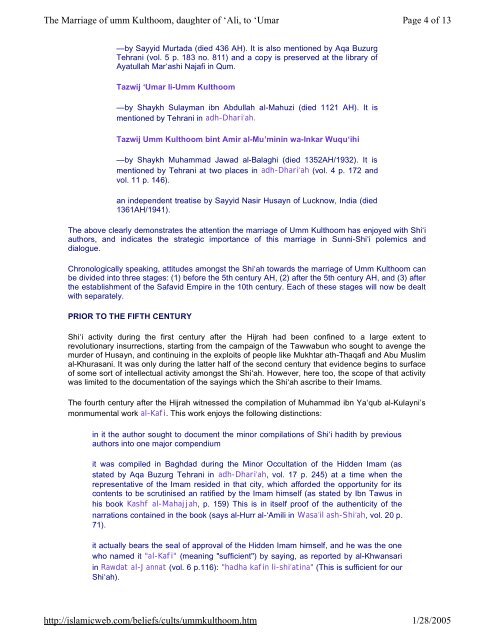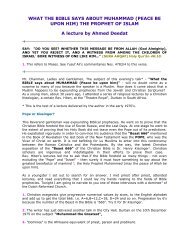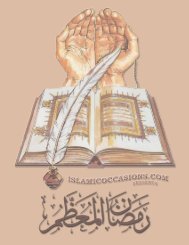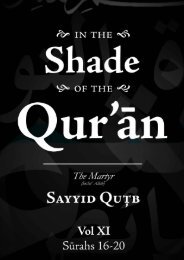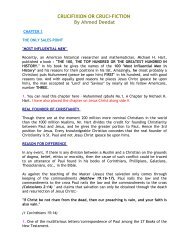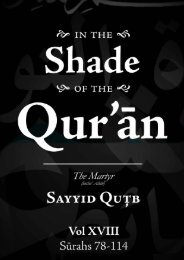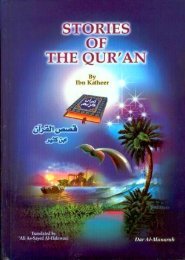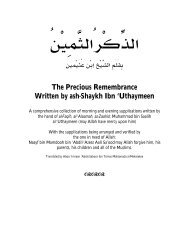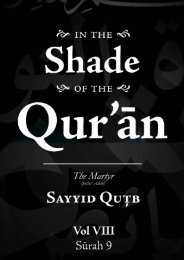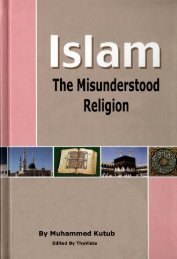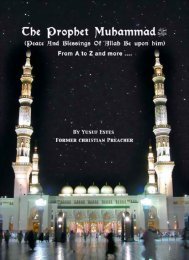Collection Of Articles (Refuting Shia) - Enjoy Islam
Collection Of Articles (Refuting Shia) - Enjoy Islam
Collection Of Articles (Refuting Shia) - Enjoy Islam
Create successful ePaper yourself
Turn your PDF publications into a flip-book with our unique Google optimized e-Paper software.
The Marriage of umm Kulthoom, daughter of ‘Ali, to ‘Umar<br />
Page 4 of 13<br />
—by Sayyid Murtada (died 436 AH). It is also mentioned by Aqa Buzurg<br />
Tehrani (vol. 5 p. 183 no. 811) and a copy is preserved at the library of<br />
Ayatullah Mar‘ashi Najafi in Qum.<br />
Tazwij ‘Umar li-Umm Kulthoom<br />
—by Shaykh Sulayman ibn Abdullah al-Mahuzi (died 1121 AH). It is<br />
mentioned by Tehrani in adh-Dhari‘ah.<br />
Tazwij Umm Kulthoom bint Amir al-Mu’minin wa-Inkar Wuqu‘ihi<br />
—by Shaykh Muhammad Jawad al-Balaghi (died 1352AH/1932). It is<br />
mentioned by Tehrani at two places in adh-Dhari‘ah (vol. 4 p. 172 and<br />
vol. 11 p. 146).<br />
an independent treatise by Sayyid Nasir Husayn of Lucknow, India (died<br />
1361AH/1941).<br />
The above clearly demonstrates the attention the marriage of Umm Kulthoom has enjoyed with Shi‘i<br />
authors, and indicates the strategic importance of this marriage in Sunni-Shi‘i polemics and<br />
dialogue.<br />
Chronologically speaking, attitudes amongst the Shi‘ah towards the marriage of Umm Kulthoom can<br />
be divided into three stages: (1) before the 5th century AH, (2) after the 5th century AH, and (3) after<br />
the establishment of the Safavid Empire in the 10th century. Each of these stages will now be dealt<br />
with separately.<br />
PRIOR TO THE FIFTH CENTURY<br />
Shi‘i activity during the first century after the Hijrah had been confined to a large extent to<br />
revolutionary insurrections, starting from the campaign of the Tawwabun who sought to avenge the<br />
murder of Husayn, and continuing in the exploits of people like Mukhtar ath-Thaqafi and Abu Muslim<br />
al-Khurasani. It was only during the latter half of the second century that evidence begins to surface<br />
of some sort of intellectual activity amongst the Shi‘ah. However, here too, the scope of that activity<br />
was limited to the documentation of the sayings which the Shi‘ah ascribe to their Imams.<br />
The fourth century after the Hijrah witnessed the compilation of Muhammad ibn Ya‘qub al-Kulayni’s<br />
monmumental work al-Kafi. This work enjoys the following distinctions:<br />
in it the author sought to document the minor compilations of Shi‘i hadith by previous<br />
authors into one major compendium<br />
it was compiled in Baghdad during the Minor Occultation of the Hidden Imam (as<br />
stated by Aqa Buzurg Tehrani in adh-Dhari‘ah, vol. 17 p. 245) at a time when the<br />
representative of the Imam resided in that city, which afforded the opportunity for its<br />
contents to be scrutinised an ratified by the Imam himself (as stated by Ibn Tawus in<br />
his book Kashf al-Mahajjah, p. 159) This is in itself proof of the authenticity of the<br />
narrations contained in the book (says al-Hurr al-‘Amili in Wasa’il ash-Shi‘ah, vol. 20 p.<br />
71).<br />
it actually bears the seal of approval of the Hidden Imam himself, and he was the one<br />
who named it "al-Kafi" (meaning "sufficient") by saying, as reported by al-Khwansari<br />
in Rawdat al-Jannat (vol. 6 p.116): "hadha kafin li-shi‘atina" (This is sufficient for our<br />
Shi‘ah).<br />
http://islamicweb.com/beliefs/cults/ummkulthoom.htm<br />
1/28/2005


